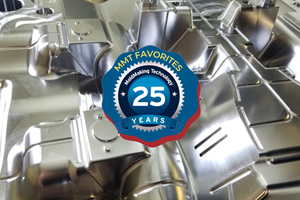Molder Only Runs One Mold with Fast Servo Motor— Instead of Two
About this series: For those charged with raising the sales of a mold building company, differentiating one’s company from the competition is fundamental. This quarterly series features actual examples of the front-line representative of a mold building company presenting new approaches to improve the customer’s profitability.
When one of its customers approached B A Die Mold with a request to redesign an existing mold for a pressure vessel in order to reduce cycle times, the company knew that its proprietary Programmable Electric Rotating Cores system would fit the bill.
According to B A Die Mold Principal Alan Petrucci, the existing molds used a conventional hydraulic cylinder and rack, and hydraulic motor unscrewing system. The mold also was oversized for the customer’s press capacities—forcing them to farm the molds to another molder with larger molding presses.
Dale Malmer, Director of Engineering Services, elaborates. “The customer was using an old hydraulic method where they had a hydraulic motor, switches and a lot of electromechanical-type controls on the mold,” he explains. “Their customer decided to come up with a new part design that would strengthen the part. They had some mechanical issues with the part. When they redesigned the part it gave them the opportunity to retool the mold. They approached us and asked us to investigate the possibility of using PERC for their part.”
Petrucci notes that the mold has two threads in each part, a large-diameter buttress thread (approximately 5 inches in diameter) and a smaller, standard 60-degree thread in the center of the part that measures about 1½ inches. “These two different unscrewing cores each have a different pitch and different-type threads in each cavity,” he elaborates. “And, the larger thread on the inside of the part had to be timed at a specific point for start and stop, and the hydraulic system didn’t always register exactly where it was supposed to be. In other words, the thread’s start inside the part was critical to positioning the part on the vessel it went on. The thread’s start was critical in relation to the part. The hydraulic system our customer was using with a hydraulic motor wasn’t always repeating the start position of the thread, which created problems for their customer—the end user. Because it is computer-controlled, the PERC system is super accurate, and thus eliminated this problem.”
In addition to solving its customer’s imminent problem of accurate core positioning, B A Die Mold’s PERC system also resulted in reduced cycle time by 40 percent—via improved cooling and faster unscrewing times—and allowed the molder to run its mold in-house due to the smaller size. The original cycle time was approximately 106 seconds. Now it is 76 seconds. Petrucci explains, “This totally new design replaced an existing mold, and gave our customer more flexibility—via more press choices due to smaller mold size and no need for hydraulic core pull—more power and a lot more reliability in the control due to exact positioning and faster rotating core speed utilizing just one drive. We made two molds for them and they are only running one because the mold runs so fast!”
Related Content
The Role of Social Media in Manufacturing
Charles Daniels CFO of Wepco Plastics shares insights on the role of social media in manufacturing, how to improve the “business” side of a small mold shop and continually developing culture.
Read MoreLeading Mold Manufacturers Share Best Practices for Improving Efficiency
Precise Tooling Solutions, X-Cell Tool and Mold, M&M Tool and Mold, Ameritech Die & Mold, and Cavalier Tool & Manufacturing, sit down for a fast-paced Q&A focused on strategies for improving efficiencies across their operations.
Read MoreMaking Quick and Easy Kaizen Work for Your Shop
Within each person is unlimited creative potential to improve shop operations.
Read MoreMaking Mentoring Work | MMT Chat Part 2
Three of the TK Mold and Engineering team in Romeo, Michigan join me for Part 2 of this MMT Chat on mentorship by sharing how the AMBA’s Meet a Mentor Program works, lessons learned (and applied) and the way your shop can join this effort.
Read MoreRead Next
Are You a Moldmaker Considering 3D Printing? Consider the 3D Printing Workshop at NPE2024
Presentations will cover 3D printing for mold tooling, material innovation, product development, bridge production and full-scale, high-volume additive manufacturing.
Read MoreHow to Use Strategic Planning Tools, Data to Manage the Human Side of Business
Q&A with Marion Wells, MMT EAB member and founder of Human Asset Management.
Read MoreHow to Use Continuing Education to Remain Competitive in Moldmaking
Continued training helps moldmakers make tooling decisions and properly use the latest cutting tool to efficiently machine high-quality molds.
Read More



















